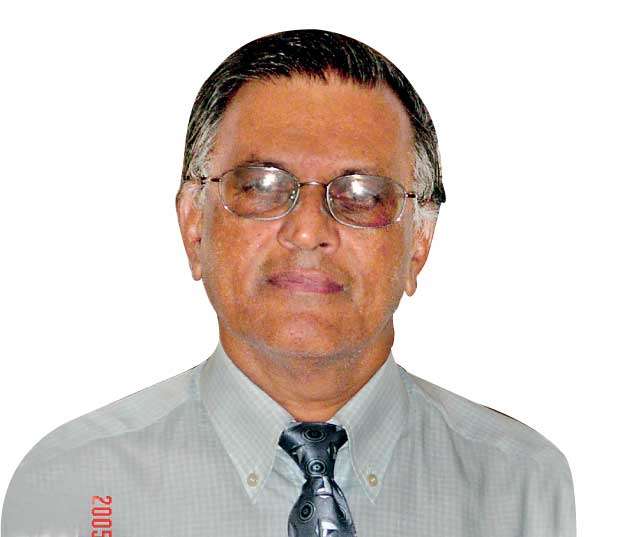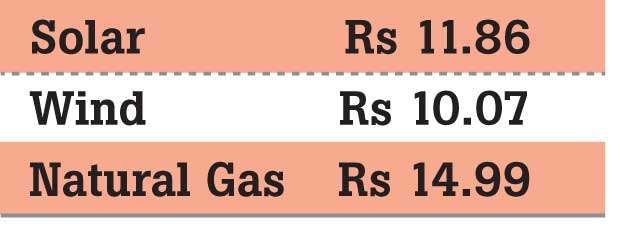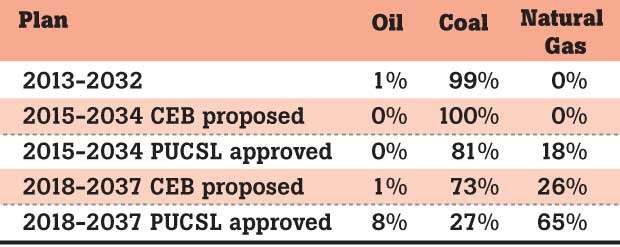22 Aug 2018 - {{hitsCtrl.values.hits}}

Parakrama Jayasinghe, a Senior Chartered Mechanical Engineer with many decades of service in public and Private sector institutions, in an interview with the Daily Mirror contested the argument by the Engineers Union of the Ceylon Electricity Board’ that coal is the most viable and cheap energy source to Sri Lanka. Jayasinghe is also the past President of the Bio Energy Association of Sri Lanka.
Excerpts:
Q CEB claims that coal is still the cheapest source of power. What are your thoughts?
Globally, coal is only cheaper than diesel from a cost perspective. The recent tenders in Sri Lanka demonstrated the following costs:
CEB of course claims coal is cheap, without reviewing their own books. CEBEU issued a circular to the members claiming it is 7.90 (lower than even the fuel cost), while submitting documents to the regulator showing it is 14.00, sans finance charges. If we assume that this plant was built with commercial funding/ROIs (so that it can be compared with the above prices) we would need to add Rs 4.00/kWh, making it more expensive than all the other sources. So any claims that coal leads to cheaper electricity is not factual. This is a myth that has been propagated over the years by all the supporters of coal power including the Ministry of Power and Energy, willfully distorting the facts, citing only the energy cost as cost of generation.
Coal is only partially viable if the country has coal reserves and can control production costs. For example, in Mundra, Gujarat, Tata and Adani had to close over 8GW of supercritical coal plants, because they were designed to run on imported coal, and were no longer financially viable to compete with cheap renewables. In India, only coal power plants that are still viable are the ones depending on cheap and dirty local coal. There is no business case for coal using imported coal in any country.
Q CEBEU claims that coal is needed for energy security. Do you agree?
I do not understand how depending on any imported fuel can give a country energy security. They cannot understand the difference between diversity and security. True energy security can only come from relying on indigenous sources. Since we do not have coal, but some natural gas, we should be focusing on a generation plan heavily reliant on renewables which are in plentiful supply at no cost together with natural gas.
CEB generation plans have never even focused on energy diversity. The ***following chart shows how consecutive CEB Generation Plans considered fossil fuel diversity in the year 2030. As you can see, CEB’s view on energy diversity is highly biased towards coal.
Q There is also an argument that coal is globally still 40% of generation and this is one reason we should develop more coal power. Do you agree with this statement?
This is a mistake of confusing current context vs the trend. At some point, we had more landlines than mobile phones, but when the number of mobile phone additions were larger than landline additions, the change was well set.
Coal is a fuel of the past, due to its impact on climate change, environmental pollution, cost and inflexibility when coupled with renewable systems. Globally coal is 38% of current generation mix, but is expected to drop drastically to 11% by 2050 according to Bloomberg energy projections. But in Sri Lanka if we follow CEB’s plan, instead of reducing our coal dependency like the rest of the world we would have increased it to 54% by 2037. Even if CEB doesn’t build any more coal plants post 2037 we will still continue to be dependent on coal with 36% of the share come 2050 by when most of the world would have shunned it.
US has stopped building coal power plants, along with EU and Australia. According to reports, a coal power plant retirement was announced in USA every 15 days during Trump presidency, despite his strong push to keep coal running. UK will shut down their coal plants by 2025. All these retiring coal plants will be replaced primarily by renewables and Natural Gas.
I do not understand how depending on any imported fuel can give a country energy security. They cannot understand the difference between diversity and security. True energy security can only come from relying on indigenous sources
EUCEB doesn’t understand how change happens. What they need to keep looking at is not what the current installed base is, but what the composition of plants that are commissioned today globally with the future in mind; especially when more non-coal additions outpace coal additions. We crossed that threshold in 2016 – now more renewables are coming on compared to fossil fuels. The composition of the grid is changing very fast with coal going down. It is dangerous as a small country to bet on a declining technology without having even our own supply of coal compounded by a depreciating currency.
Q There is a claim that as a poor country Sri Lanka should look for coal, and suggests countries such as Vietnam, Malaysia, Indonesia and Bangladesh as those who are building coal plants. There is also a claim that Indonesia, Australia and Bangladesh export Natural Gas while generating power via coal. Why is that?
Vietnam, Malaysia Indonesia and Australia all have large coal deposits. Some are building coal to utilise their energy source for energy security (note Australia are no longer building coal plants, even the so called clean coal type). So it doesn’t make sense to follow them. We do not have coal, so comparing with them isn’t useful or relevant.
If you look at the two coal plants being built by Bangladesh – at Godda (located in India selling power to Bangladesh at very high cost) and Rampal (with massive ecological impact in Sundarbans a UNESCO world heritage mangrove forest), they aren’t cheap and come with huge social/ecological costs. The CEB’s Norocholai coal power plant is a living testimony of an environmental disaster.
We are no longer a poor country – we are a middle income country. EUCEB is too ingrained with a colonized thinking pattern. They are running around with an old paradigm of electricity generation which is no longer valid. No other industry in Sri Lanka goes for outdated technology claiming we’re poor. Our telecom technology isn’t second to others. Nor is our IT industry, apparel, rubber products etc. The country is full of hybrid and electric cars. Why should we settle for a lesser technology? Does EUCEB engineers use old Nokia phones and rotary dial land phones?
At some point we built a fantastic hydro-electricity network, we innovated mini-hydro industry and now our companies are taking these technologies to other parts of the world. Current EUCEB wants to be a follower of old technology and get the whole country stuck in their outdated model.

Q What changes do you see in the region and around the world that we can take notice of?
First, we have to recognise that there are even developing countries that have had the courage to build a pathway on renewables. A good example is Costa Rica which is building a fossil fuel free plan for itself. Even if we look at a country like India, even with its large coal addiction, the changes they are seeing are amazing, not forgetting the timelines for it.
India thought of developing 175GW of renewables from 2017-2022, and are now already adding another 100GW into that equation by the same end date. They managed to really reduce costs of renewables by going on scale – the Minister recently spoke about doing a 100GW solar contract, along with battery storage, while our Minister is still thinking at a scale of 1MW. This is how you reduce costs, by leveraging scale and reducing transaction costs.
They have begun shutting down coal plants running on imported coal, and cancelling planned coal plants. Just last week NTPC cancelled 4GW project 4 years in the planning in Andhra Pradesh.
Because their transmission companies have been separated from generation entities, the discoms are now refusing to sign any power purchase agreement over a period of 15 years – hitting hard on coal power. They know renewables are reducing costs, and do not want to be locked down to long term expensive coal power. These trends show that the era of renewables is truly here, and India is planning to use it to reduce the costs to the consumer. You cannot do that by locking at imported coal power.
EUCEB doesn’t understand how change happens. What they need to keep looking at is not what the current installed base is, but what the composition of plants that are commissioned today globally with the future in mind; especially when more non-coal additions outpace coal additions
There is a lot that India has to do better, but if we can see the direction they are taking, we can make a miraculous transformation of our energy systems and reduce costs for the consumers, without polluting the country.
Q You have been a long term promoter of biomass energy. Where is biomass in this equation?
Biomass is the most talked about underused renewable source in this country. We have ample scrubland and land not used – which can be converted to biomass plantations, and develop them into biomass based electricity. We need to look at the overall impact of biomass – if used strategically, this is one of the biggest rural poverty alleviation programmes we can run. Instead of spending millions of dollars on imported fossil fuel, we will channel it to the rural poor and lift them out of poverty. This would really democratise energy generation in the country, moving it away from a few rich businessmen and politicians, to rural masses. A 10 MW Denro power plant will infuse over Rs 500,000,000 annually to the rural economy just by the sale of Gliricidia Fuelwood. The other spin off benefits are many fold.
Q Do you think CEB is anti-renewable?
Yes, I believe as an organisation they are, although not all engineers in CEB are so, and any renewable energy developer will agree with me. The amount of trouble we have to endure to develop projects is unheard of. If you are a solar developer, you spend months waiting for a connection. CEB recently changed the rules all of a sudden for NetPlus, until the minister intervened to reverse the decision. For two years, CEB has blocked giving PPAs to mini-hydro and biomass power producers asking them to be tendered irrespective of the established law of feed-in tariffs. These are arbitrary decisions. We have been forced to go to the court seeking resolution.
CEB is blocking Mannar wind power projects and has been doing it for years, claiming only they should develop it. It is well understood that the private sector can keep the costs much lower than the CEB, and that CEB cannot develop these due to lack of funds. What is being developed with ADB funds is a fraction of wind potential, and they are not allowing anything else to be developed. This is such a loss to the country. The roof top solar is making steady progress in spite of the many obstacles placed by the CEB. But the CEB is dragging its feet on the 1 MW solar park tenders that they themselves floated and received attractive prices which were much below the actual cost of coal power.
There are over 80 MW odd Dendro power projects which are in various stages of the approval process which have been blocked completely during the last two years. The number of projects using other technologies is of the same order.
I can go on, the list is quite long.

Q What does an ideal future energy scenario look like for Sri Lanka?
I see it dominated by renewables, with large scale wind, solar, hydro and Dendro power adding electricity. Of course this system will be balanced using some natural gas and utility scale battery storage (hydro can also do the balancing). This is not a far-fetched idea – if we look at price and technology trends, getting close to this by 2030 is definitely in the books. But that requires all parties to look beyond this old paradigm of fossil fuel driven baseload power. Such a system will preserve our foreign exchange, and pass the economic benefit to our own people without being a burden to the country.
Distributed solar and wind will ease out fluctuations, solar will complement wind and hydro and we have an excellent combination. Dendro and gas will provide system stability. This is eminently doable. Our current energy demand can be fully met with developing 20% of the total wind potential, or with 0.5% of landmass covered with solar panels (can be rooftops and reservoirs). We have potential, but need the will and thinking engineers to string them together with smart storage technology and gas.
Building more coal power will actually block this progress as coal is too inflexible a technology. We can see it being played out already. The CEB is developing 100MW of windpower in Mannar, but they wanted the system to be designed to curtail wind power so that coal can run at full capacity. Imagine that! In Germany and even in India, when renewables are there, they force curtailment of coal, and in Sri Lanka, we curtail free wind power (at 0 dispatch cost) so that we can burn more coal and pollute the country and drive up costs.
Q What are your thoughts on Norocholai?
Nothing but a total disaster for the people around and also for those far away from the power plant. At least EUCEB now accepts that there are serious issues. We have a fly ash mountain 8m tall, polluting the neighbourhood. Mr. Kumarawadu talks about ESP and FGD – but how often do they break? It was reported that one plant had a broken ESP for months before being forced to shut down by the environmental authorities. The whole country saw how they dumped fly ash into the ocean on two days in March and April. These are not design faults – these are caused by the mismanagement of the existing infrastructure through gross negligence.
It was reported that the plant emits 580kg of mercury (a major neuro toxin) to the ocean and air per year. ESP cannot trap mercury. How much damage can 580kg of mercury do in our country when a teaspoon of mercury can pollute a 25 acre lake?
Mr Kumarawadu speaks of high chimneys – but they only change the location of deposition. It still falls within the country. Who changed the coal supply country of origin? It is the Noracholai plant management who changed the slightly better Indonesian coal to the current South African coal because they couldn’t control self-combustion. What I see is EUCEB avoiding the issue, rather than accepting their own role in this disaster and rectifying it.
Q CEB claims that there is only natural gas for a single 1000MW plant. Is that correct in your opinion?
Luckily the developers who are interested in the Mannar gas fields have better information than Mr Kumarawadu. No serious developer would come to Sri Lanka if the estimated deposits are so low. The most conservative quantification would be at least 5 times that size – enough to power our NG plants and provide much needed, clean thermal energy for Sri Lankan industry. You can check this with PRDS. The likely available amount is higher. We will save our foreign exchange and keep the Rupee stable too when we develop the same.
Q As a stakeholder, what is your view of CEBEU, PUCSL conflict?
EUCEB wants to run as if they control the country and the politicians, claiming they are a professional union. What they proved to the country is that they were ready to hold the country, its economy and well-being of the people to ransom, for a misguided plan to build more coal plants. And they did this by lying to the President and the people about the real costs of coal power.
Q What were the problems regarding their plan?
Well the assumptions of course. CEB used a coal price of USD 69.75/ton as coal costs for 30 years while buying coal at USD100/ton. We are buying coal at USD 120/ton now. They also used USD10/MMBTU for gas, when PRDS said that their negotiations were looking at a price of USD8.40/MMBTU. By artificially inflating the costs of Natural gas and reducing the cost of coal, they tried to show that coal based generation is cheaper.
 Furthermore EUCEB continues to claim that the PUCSL has approved a LTEGP prepared by them. This is a total lie, designed to mislead the public. What the PUCSL did was to correct the input parameters submitted by the CEB. This resulted in the alternative submitted by the CEB itself ‘No Coal Option’ emerging as the least economic cost option, rather than the Base Case option with many coal power plants for which the CEBEU is agitating for. It is clear that they would even propagate such lies which are easily debunked by anyone using the data in the public domain.
Furthermore EUCEB continues to claim that the PUCSL has approved a LTEGP prepared by them. This is a total lie, designed to mislead the public. What the PUCSL did was to correct the input parameters submitted by the CEB. This resulted in the alternative submitted by the CEB itself ‘No Coal Option’ emerging as the least economic cost option, rather than the Base Case option with many coal power plants for which the CEBEU is agitating for. It is clear that they would even propagate such lies which are easily debunked by anyone using the data in the public domain.
There were many other problems in the generation plan. The plan had to have the least economic cost (that includes social/environmental externalities) which CEB conveniently ignored. Such changes were designed to show that coal is cheaper than gas. If we followed that plan, it would have cost the country Billions more.
CEB wants to claim that the only thing PUCSL can do is to approve the base case plan sent by CEB, irrespective of its faulty assumptions or any other errors. They want the regulator to be a rubber stamping authority. This is completely against the intent and the phrasing of the Electricity Act and sounds downright silly. No regulator in the world acts like that.
What they were trying to do is also completely unethical. They were flexing their political muscle, through the Minister, Secretary and the President to exert political influence on an independent commission, and forcibly remove its commissioners and Director General. This is what this country wanted to avoid with the 19th Amendment to the Constitution, to keep the commissions independent. The President or any other party cannot influence the PUCSL according to the laws of the country. So EUCEB took trade union action asking the Government to do something illegal. This doesn’t sound like a ‘professional’ union to me.
What EUCEB wants is to take away the regulatory oversight. If it wasn’t for PUCSL, the public wouldn’t know that real costs of Noracholai is Rs 14.00+ and EUCEB could go around claiming it is 7.90, misleading people. Even now, since they are in non-cooperation mode, they refuse to submit generation data and costs to PUCSL, allowing them to do whatever they want and do all these acts without being noticed by the public. Given their track record of corruption, this is dangerous to the whole country.
Luckily the developers who are interested in the Mannar gas fields have better information than Mr Kumarawadu. No serious developer would come to Sri Lanka if the estimated deposits are so low. The most conservative quantification would be at least 5 times that size – enough to power our NG plants and provide much needed, clean thermal energy for Sri Lankan industry
Mr Kumarawadu claims that the Director General of PUCSL lied – which is an unsubstantiated claim. Mr Kumarawadu is the one who told the country that Norocholai cost is Rs 7.90/kWh, which is a blatant lie. He said that Sulphur Dioxide levels of Norocholai plant are 0 and 5 (presumably mg/Nm3). Both numbers are impossible to reach with the current technology –which is another blatant lie. If Mr Kumarawadu wants other people sacked for ‘lying’ he should resign from his position first.
10 Jan 2025 1 hours ago
10 Jan 2025 2 hours ago
10 Jan 2025 4 hours ago
10 Jan 2025 4 hours ago
10 Jan 2025 4 hours ago